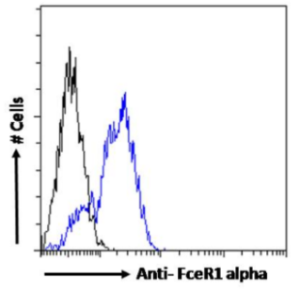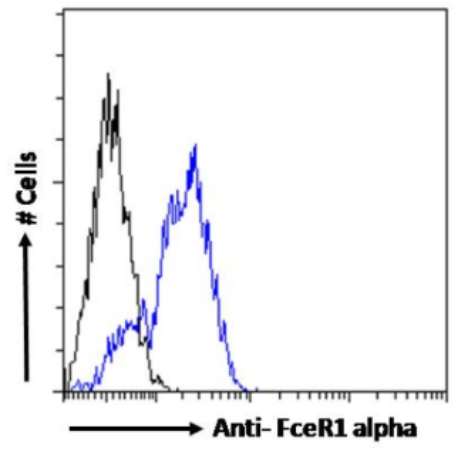![absoluteantibody/Anti-FceR1 alpha [Mar-1]/200 μg/Ab01187-2.0](images/no_picture.gif)
UniProt Accession Number of Target Protein: P20489
Alternative Name(s) of Target: Fc epsilon RI alpha; FceRIa; FceRI alpha; FceRI-α; high affinity IgE receptor; High affinity immunoglobulin epsilon receptor subunit alpha; Fcer1a; Fce1a; Fc-epsilon RI-alpha; FcERI; IgE Fc receptor subunit alpha
Specificity: This antibody specifically targets the non-signalling alpha chain of the FceR1 complex.
Application Notes: This antibody has been used in flow cytometric analysis of FceR1 alpha cell surface expression by basophils (Min et al, 2004; Chen et al, 2009), and immunohistochemical analysis of epidermal sheets (Holzmann et al, 2004). It has also been used in immunoprecipitation analysis of cell lysates from lung cDCs and MC/9 mast cells (Grayson et al, 2007). In vitro incubation of basophils with this antibody blocks subsequent MAR-1 staining, but does not activate basophil IL-4 production (Sokol et al, 2008). Intravenous treatment of mice with this antibody results in basophil depletion in peripheral blood, spleen, bone marrow and liver, but not skin or intraperitoneal mast cell depletion (Sokol et al, 2008). Following treatment with this antibody, basophil-depleted mice display impaired Th2 differentiation upon papain immunisation (Sokol et al, 2008). However, MAR-1 treated mice respond normally to high-dose intravenous Ig in both the K/BxN serum transfer arthritis and collagen-induced arthritis models, despite basophil depletion (Campbell et al, 2014).
Antibody first published in:Holzmann et al.A model system using tape stripping for characterization of Langerhans cell-precursors in vivo.J Invest Dermatol. 2004 May;122(5):1165-74.PMID:15140219Note on publication:Describes the original use of this antibody in immunohistochemical analysis of epidermal sheets.


Flow-cytometry using the anti-FceR1 alpha antibody Mar-1 (Ab01187) Mouse splenocytes were stained with anti-Fluorescein IgG antibody (4-4-20; isotype control, black line) or the rabbit IgG-chimeric version of Mar-1 (Ab01187-23.0, blue line) at a dilution of 1:100 for 1h at RT. After washing, bound antibody was detected using a goat anti-rabbit IgG AlexaFluor® 488 antibody at a dilution of 1:1000 and cells analyzed using a FACSCanto flow-cytometer.
ebiomall.com






>
>
>
>
>
>
>
>
>
>
>
>
按作用对象,可将其分为抗毒素、抗菌抗体、抗病毒抗体和亲细胞抗体(能与细胞结合的免疫球蛋白,如1型变态反应中的lgE反应素抗体,能吸附在靶细胞膜上)。
按理化性质和生物学功能
按理化性质和生物学功能,可将其分为IgM、IgG、IgA、IgE、IgD五类。
IgM抗体是免疫应答中首先分泌的抗体。它们在与抗原结合后启动补体的级联反应。它们还把入侵者相互连接起来,聚成一堆便于巨噬细胞的吞噬;
IgG抗体激活补体,中和多种毒素。IgG持续的时间长,是唯一能在母亲妊娠期穿过胎盘保护胎儿的抗体。他们还从乳腺分泌进入初乳,使新生儿得到保护;
IgA抗体进入身体的黏膜表面,包括呼吸、消化、生殖等管道的黏膜,中和感染因子。还可以通过母乳的初乳把这种抗体输送到新生儿的消化道黏膜中,是在母乳中含量最多,最为重要的一类抗体;
IgE抗体的尾部与嗜碱细胞、肥大细胞的细胞膜结合。当抗体与抗原结合后,嗜碱细胞与肥大细胞释放组织胺一类物质促进炎症的发展。这也是引发速发型过敏反应的抗体;
IgD抗体的作用还不太清楚。它们主要出现在成熟的B淋巴细胞表面上,可能与B细胞的分化有关。(IgD于1995年从人骨髓瘤蛋白中发现,分子量为175kD,主要由扁桃体、脾等处浆细胞产生,人血清中IgD浓度为3~40μg/ml,不到血清总Ig的1%,在个体发育中合成较晚。IgD铰链区很长,且对蛋白酶水解敏感,因此IgD半衰期很短,仅2.8天。血清中IgD确切的免疫功能尚不清楚。在B细胞分化到成熟B细胞阶段,除了表达SmIgD,抗原刺激后表现为免疫耐受。成熟B细胞活化后或者活化后或者变成记忆B细胞时,SmIgD逐渐消失。)
按可见反应
按与抗原结合后是否出现可见反应,可将其分为:在介质参与下出现可见结合反应的完全抗体,即通常所说的抗体,以及不出现可见反应,但能阻抑抗原与其相应的完全抗体结合的不完全抗体。
按抗体来源
按抗体的来源,可将其分为天然抗体和免疫抗体。
抗体就是免疫球蛋白,是改变了的球蛋白分子。由特异性抗原刺激产生,抗体的产生是由于抗原侵入人体后引起各种免疫细胞相互作用,使淋巴细胞中的B细胞分化增殖而形成浆细胞,浆细胞可产生分泌抗体。
按抗体发展
单克隆抗体的发展经历了四个阶段,分别为:鼠源性单克隆抗体、嵌合性单克隆抗体、人源化单克隆抗体和全人源单克隆抗体。
鼠源性单克隆抗体:鼠杂交瘤单克隆抗体主要是将来源于免疫接种过的小鼠的B 细胞与骨髓瘤细胞融合,继而筛选出既能无限增殖又能分泌抗体的鼠杂交融合细胞,进而进行筛选、抗体制备和抗体纯化。
嵌合性单克隆抗体:指用人的恒定区取代小鼠的恒定区,保留鼠单抗的可变区序列,形成一个人-鼠杂合的抗体。其研制程序快,可大幅度降低异源抗体的免疫原性,却几乎保持亲本鼠单抗全部的特异性和亲和力。另外,它还具有人抗体的效应功能,如补体固定、抗体依赖细胞介导的细胞毒作用(ADCC)等。
人源化单克隆抗体:利用现有的无数已详细分析过的小鼠抗体,取其与抗原直接接触的那段抗体片段(互补决定区,CDR)与人的抗体框架嫁接,经亲和力重塑,可维持其特异性和大部分的亲和力,同时几乎去除免疫原性和毒副作用。
全人源单克隆抗体:其抗体的可变区和恒定区都是人源的,去除免疫原性和毒副作用。全人源抗体制备的相关技术主要有:人杂交瘤技术、EBV 转化 B 淋巴细胞技术、噬菌体显示技术(phage display)、转基因小鼠抗体制备技术(transgenic mouse)和单个B细胞抗体制备技术等。
由人源化和全人源抗体制备的人源化和全人源抗体药物因其具有高亲和力、高特异性、毒副作用小的特点,克服了动物源抗体及嵌合抗体的各种缺点,已经成为了治疗性抗体药物发展的必然趋势。展开
2、对人体疾病而言,按照经典且目前行之有效的疫苗和免疫学角度看,中和抗体对预防这类疾病更有效。但很多资料也表明,可能那些non-neutralizing但具有其他作用的功能性抗体在控制和预防感染性疾病中也发挥着十分重要的作用,例如补体作用,ADCC,ADCVI等等。
在免疫检测中:由于缺少Fc段,Fab不能沉淀抗原,也不能被活体的免疫细胞所识别;但拥有小分子量和交叉反应小的优点,因此常用于放免中的功能研究,也用于阻断细胞、组织内源性的免疫球蛋白及在多重免疫标记中,一抗来源于同一种属时,阻断已经暴露的IgG抗原决定簇;在实际临床应用中:目前临床应用的全抗大多数是所谓人源化抗体,也就是使用的是人IgG的骨架,但是可变区插入的是小鼠的和抗原结合的片段。虽然人源化抗体避免了种属之间的反应,但是同种属之间反复或者长期使用,由于Fc片段的存在还是可能产生自身抗体,所以人们就使用木瓜酶消化IgG,得到Fab片段,理论上Fab片段保证了抗体和抗原结合的特性,但是避免了自身抗体的可能,因为没有Fc段,片段较小,免疫原性较小。但是由于分子量较小,因此在体内代谢很快,也就是作用时间短。如果是长期使用,也就增加了用药的次数。
专精免疫学,有问题请追问!
其主要作用就是人体的防御军队,抵抗外来的病毒、细菌的侵袭。









